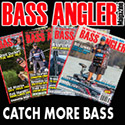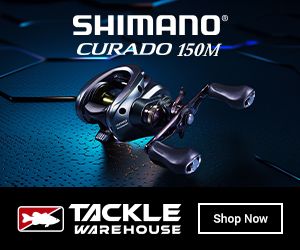In The Mood ... For Jigs, 2009 Jig
Roundup

|
Date: |
11/1/09 |
|
Tackle type: |
Jigs |
|
Manufacturer: |
Varied |
|
Reviewer: |
Cal |
Introduction: As classic as Glenn Miller’s 1940’s swing tune, the jig is about as basic as it gets in bass fishing. Want a big fish? Grab a jig, add your favorite trailer, tie it on, pitch it out, hop left, hop right, hop back, swing! Ok, maybe it’s not THAT easy, but just about every bass angler knows, learning how to fish a jig successfully is one of the very basic first steps in doing the big bass dance.

Jig fishing on El Novillo Lake in Mexico.
Of course, just as with any dance, the bass jig has countless variations. There are jigs for rocks, jigs for grass, jigs that do the swim, jigs that punch, hybrid jigs, jigs designed to stand up, jigs designed to slow fall. Perhaps the only thing that outnumbers the variety of jigs available today is the number of manufacturers pouring, tying, or banding them up! How is any bass fisherman expected keep track? Well, how about through what is becoming an annual affair here at TackleTour? Presenting our 2009 Jig Roundup!

Jigs are a good way to pull up a quality stringer, but that doesn't mean you still won't catch the aggressive smaller fish too.
But before we get into the products, let’s discuss the basic attributes that distinguishes one jig from the other and what we’ll use in our evaluation of each product:

What's in the package? Some jigs come with rattles, some do not.
The Skirt: Some manufacturers choose rubber, some choose silicone, some choose a combination of both and add mylar strands on top of it all. Rubber flares better in the water, but silicone can be made with more intricate colors. Which one is better is a matter of personal preference and confidence.

Rubber has more bulk and flare than silicone.
What’s more important than the skirt material is the method by which it is attached to the jig head. Hand tied gets bonus points here on TackleTour. The skirts that are hand tied not only stay together longer, they flare better because the skirt material is pressed more tightly against the jig head. Those that are banded onto the jighead are easier to manufacture but we’ve had too many of these bands fail. There is a new method growing in popularity of using a wire tie instead of the traditional thread. We’re still of the opinion thread can be tied tighter than the wire ties.

Some manufacturers use wire to tie the skirts rather than thread.
The Hook: Name brands are always confidence inspiring, but as long as the hook on a jig is sharp enough and durable enough (proven through use), then we’re ok with it. Just don’t charge a premium for a jig without a name brand hook.

Bait keepers are another variant - some manufacturers provide them, some do not.
Head & Position of Line Tie: The head design depends on the jig’s intended application and will be included in our evaluation simply as a point of information. A seemingly innocuous data point however, that some manufacturers go out of their way to position just right is the line tie. Some do it in such away to provide a tie that is concealed, others position it in such a way as to ensure proper positioning of the jig head when it’s sitting on the bottom or being worked over structure. Some take both into consideration. Position of the line tie can effect how easily the jig snags or how much abuse the knot receives while being fished. This is where our on the water experience with each jig comes into play.

The single most identifiable attribute on a jig is its head. Here, D&M offers their interpretation of the arkie.
Durability: There seem to be several different methods of applying paint to the head of the jig. Each manufacturer is going to claim theirs is the best. In the end, does paint on the jighead make a difference? Well it does to us because it’s one factor we can objectively evaluate. Our torture test for jig heads? Aside from fishing them, the first thing we do when we get a new jig to test is walk outside and toss it up in the air. If the paint is still intact after we pick it up off the sidewalk then it passes the first test - simple as that.

Most jigs intended for weeds come with very stout hooks.
So off we go. Each product in the following pages has been fished and abused though not necessarily in that order. Some have caught fish, others may have not, but with a jig, it’s really only a matter of time. As long as you can work it the way you want, and the bait holds up to extended use, that’s what’s important here.



























